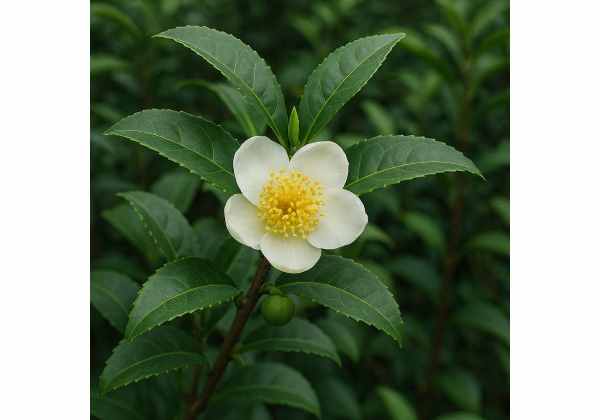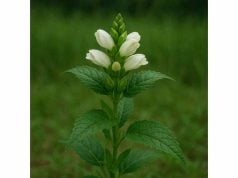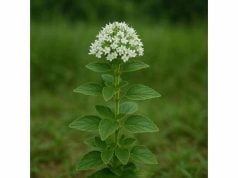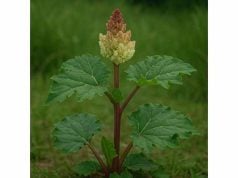
The Tea Plant, botanically known as Camellia sinensis, is the source of one of the world’s most cherished beverages and a treasure trove of bioactive compounds. Rich in antioxidants, polyphenols, and amino acids, it offers remarkable anti-inflammatory, cardiovascular, and neuroprotective benefits. Traditionally used in various cultures for its calming properties and digestive support, tea is enjoyed both as a daily beverage and as a component in holistic wellness regimens. Its versatile composition not only caters to culinary pleasures but also plays a role in traditional medicine and modern health products worldwide.
Table of Contents
- Botanical Heritage and Identification
- Chemical Spectrum and Vital Bioactive Constituents
- Therapeutic Advantages and Core Wellness Attributes
- Practical Applications and Safe Use Considerations
- Scientific Validation and Research Milestones
- Frequently Asked Questions
Botanical Heritage and Identification
The Tea Plant, Camellia sinensis, belongs to the Theaceae family and is native to Asia, particularly regions of China and India. It is a small evergreen shrub or tree that thrives in subtropical climates, often found in hilly terrain with well-drained, acidic soils. The plant features glossy, dark-green leaves with serrated margins and clusters of small, white flowers that bloom seasonally. These flowers eventually give way to seed pods. The variety of tea—green, black, oolong, or white—is determined largely by processing methods, though subtle botanical differences exist between cultivars. Over centuries, selective breeding has honed these varieties for flavor, aroma, and medicinal potential.
Tea Plant’s adaptability is evident in its diverse growth patterns; it can be pruned to form compact bushes ideal for garden cultivation or allowed to grow taller in its natural habitat. The leaves, rich in chlorophyll and bioactive molecules, are the primary harvest for tea production. In traditional tea gardens, meticulous care is taken to maintain soil pH and ensure proper shading, which directly influences the taste and quality of the leaves. This botanical heritage not only defines the flavor profile of tea but also lays the groundwork for its therapeutic applications.
Taxonomically, Camellia sinensis is classified into two main varieties: C. sinensis var. sinensis and C. sinensis var. assamica. The former is generally associated with Chinese tea and is characterized by smaller, tender leaves and a more delicate flavor, whereas the latter, native to the Assam region of India, produces larger leaves with a bolder taste. The subtle differences in morphology and cultivation practices between these varieties underscore the tea plant’s rich genetic diversity and its adaptability to various climates and soil types.
Historically, the Tea Plant has been woven into the fabric of numerous cultures. In ancient China, tea was not merely a beverage but a symbol of refinement, celebrated in literature, art, and ritual. Over time, tea cultivation spread to Japan, India, and eventually the Western world, each culture adapting its use based on local customs and medicinal traditions. This widespread appreciation has led to extensive research into the plant’s properties and numerous innovations in its cultivation and processing.
Modern tea gardens utilize both traditional and contemporary agricultural techniques to optimize leaf quality. Methods such as selective pruning, organic fertilization, and controlled shade-grown systems help enhance the concentration of beneficial compounds in the leaves. Researchers have documented that environmental factors—such as altitude, soil composition, and water quality—significantly affect the phytochemical profile of the tea leaves, highlighting the intricate interplay between nature and nurture in tea production.
In summary, the Tea Plant’s botanical heritage and identification reveal a species that is not only culturally and historically significant but also biologically diverse and adaptable. Its well-documented taxonomy, distinctive physical characteristics, and finely tuned cultivation practices all contribute to the high quality and varied uses of tea. Whether enjoyed for its sensory pleasures or consumed for its health-promoting properties, the tea plant remains a critical component of both ancient traditions and modern lifestyles.
Furthermore, ongoing botanical research and genetic studies are shedding light on the evolutionary adaptations of Camellia sinensis. These studies help plant scientists and agriculturalists develop improved cultivars that are more resistant to diseases and environmental stresses, ensuring that tea remains a sustainable and high-quality crop for future generations. The continual refinement of cultivation and processing techniques guarantees that the legacy of the tea plant continues to flourish across different regions and cultural contexts.
Chemical Spectrum and Vital Bioactive Constituents
The rich flavor and renowned health benefits of tea are deeply rooted in its intricate chemical profile. The Tea Plant synthesizes a wide array of bioactive compounds that contribute to its unique taste, aroma, and medicinal properties. Advanced analytical techniques have identified key constituents including polyphenols, catechins, caffeine, L-theanine, flavonoids, and various volatile organic compounds.
A closer examination of these constituents provides insight into how tea achieves its health-promoting effects:
- Catechins: Catechins are a subtype of polyphenols that are highly concentrated in tea, particularly in green tea. These powerful antioxidants, such as epigallocatechin gallate (EGCG), help neutralize free radicals, reduce oxidative stress, and protect cellular structures from damage. Their anti-inflammatory properties also contribute to cardiovascular health.
- Caffeine: Caffeine, a natural stimulant found in tea, enhances alertness and cognitive function by blocking adenosine receptors in the brain. It is also known to boost metabolism and increase fat oxidation, making it a popular compound in weight management strategies.
- L-Theanine: An amino acid almost exclusively found in tea, L-theanine promotes relaxation and counteracts the jittery effects of caffeine. It is known to enhance mood, improve focus, and support a calm yet alert mental state by influencing neurotransmitter levels.
- Flavonoids: Flavonoids contribute not only to the vibrant color and taste of tea but also play a vital role in reducing inflammation and supporting immune function. They work synergistically with catechins to augment the overall antioxidant capacity of tea.
- Polyphenols: In addition to catechins, tea contains a variety of polyphenols that provide robust antioxidant defense. These compounds help mitigate the risk of chronic diseases such as cancer, diabetes, and neurodegenerative disorders by inhibiting oxidative processes.
- Volatile Organic Compounds (VOCs): The aromatic profile of tea is largely due to its complex blend of VOCs, which include compounds like linalool, geraniol, and methyl salicylate. These substances contribute to tea’s distinctive fragrance and may also possess antimicrobial and anti-inflammatory properties.
Beyond these major constituents, the Tea Plant also produces trace elements such as manganese, fluoride, and other minerals that are essential for various metabolic processes. The synergistic interaction among these diverse compounds not only defines the sensory experience of tea but also underpins its remarkable health benefits. Each sip of tea delivers a complex cocktail of nutrients that work together to promote well-being.
Innovative extraction methods and advanced chromatographic techniques have allowed researchers to analyze the detailed composition of tea in unprecedented depth. Gas chromatography–mass spectrometry (GC-MS) and high-performance liquid chromatography (HPLC) have been instrumental in identifying the nuanced interplay between different bioactive compounds. These studies help in standardizing tea extracts for use in nutraceutical formulations and in the development of functional beverages that target specific health concerns.
Furthermore, the concentration of these bioactive components can vary depending on factors such as cultivation practices, geographic origin, and processing methods. For instance, green tea typically retains a higher concentration of catechins and L-theanine due to minimal oxidation during production, whereas black tea undergoes more extensive oxidation, leading to a different polyphenolic profile. This variability allows consumers to select teas that best suit their taste preferences and health needs.
In summary, the chemical spectrum of the Tea Plant is extraordinarily diverse, featuring an array of compounds that contribute to its health-enhancing properties. The combined effects of catechins, caffeine, L-theanine, flavonoids, polyphenols, and volatile organic compounds work synergistically to offer protection against oxidative stress, promote mental alertness, and support overall cellular health. This complex phytochemical matrix makes tea one of the most extensively studied and appreciated natural beverages in the world.
Ongoing research continues to uncover new insights into the interactions among these active components. Such studies are paving the way for the development of novel tea-based products that leverage this rich chemical diversity to target specific health issues. As scientific techniques evolve, our understanding of the Tea Plant’s chemistry will only deepen, further solidifying tea’s role as a cornerstone of both traditional and modern wellness practices.
Therapeutic Advantages and Core Wellness Attributes
The Tea Plant has long been esteemed for its capacity to promote health and wellness. Its array of bioactive compounds delivers a wide range of therapeutic benefits that include potent antioxidant activity, cardiovascular support, enhanced cognitive function, and anti-inflammatory effects. These properties collectively make tea a powerful ally in the pursuit of holistic health.
One of the primary advantages of tea is its high antioxidant content. The presence of catechins and polyphenols helps combat oxidative stress, a critical factor in aging and many chronic diseases such as cancer and diabetes. By scavenging free radicals, these antioxidants help protect cellular integrity and reduce the risk of disease development.
Tea is also celebrated for its cardiovascular benefits. Regular consumption has been associated with improved blood vessel function, lower blood pressure, and reduced levels of LDL cholesterol—the so-called “bad cholesterol.” These effects help mitigate the risk of heart disease and stroke, contributing to better overall cardiovascular health.
Moreover, tea supports mental well-being through the combined actions of caffeine and L-theanine. While caffeine increases alertness and focus, L-theanine helps foster a calm, relaxed state, reducing anxiety and stress. This balance not only boosts mood but also improves cognitive performance, making tea an ideal drink for both work and leisure.
Inflammation is a common contributor to numerous health conditions, including arthritis and metabolic syndrome. The anti-inflammatory properties of tea—attributed largely to its flavonoids and polyphenols—help reduce inflammation at the cellular level. This, in turn, supports immune function and promotes faster recovery from minor injuries and illnesses.
Additionally, tea has been linked to improved digestive health. Certain bioactive compounds in tea stimulate the production of digestive enzymes and enhance gut motility, facilitating better digestion and nutrient absorption. This makes tea a popular post-meal beverage in many cultures, appreciated for its ability to soothe the digestive tract and reduce bloating.
Emerging research also suggests that regular tea consumption may offer protective effects against neurodegenerative conditions such as Alzheimer’s disease and Parkinson’s disease. The antioxidant and anti-inflammatory activities of its components may help preserve neural function and slow cognitive decline, thereby supporting long-term brain health.
Furthermore, tea’s potential role in weight management is garnering considerable attention. By boosting metabolism and enhancing fat oxidation, the caffeine and catechins in tea can help facilitate weight loss when combined with a balanced diet and regular exercise. This multifaceted action makes tea an integral part of many healthy lifestyle routines.
In summary, the therapeutic advantages and core wellness attributes of the Tea Plant are extensive. From guarding against oxidative stress and supporting heart health to promoting mental clarity and digestive well-being, tea offers a holistic suite of benefits that cater to multiple aspects of physical and mental health. Its natural composition provides an effective, accessible means to enhance quality of life and foster long-term wellness.
As the global population increasingly turns toward natural remedies and preventative health strategies, tea remains at the forefront of these trends. Its time-honored usage, backed by modern scientific research, underscores its standing as one of the most beneficial natural beverages available today. Whether enjoyed as a soothing hot drink or consumed as part of a comprehensive wellness regimen, the Tea Plant continues to serve as an essential element in the pursuit of holistic health.
Moreover, the cultural significance of tea, intertwined with its medicinal virtues, creates a unique blend of tradition and modernity. Daily rituals involving tea not only offer health benefits but also provide moments of relaxation and mindfulness, reinforcing its role as a symbol of well-being in both social and personal contexts.
Practical Applications and Safe Use Considerations
The versatility of the Tea Plant extends far beyond its role as a beverage—it plays a significant part in culinary, medicinal, and even cosmetic applications. In the culinary sphere, tea is enjoyed in various forms, from traditional brewed beverages to innovative recipes that incorporate tea-infused ingredients in desserts, marinades, and even savory dishes.
One of the most popular and traditional applications is the consumption of tea as a hot or cold infusion. Whether prepared in the classic Chinese gongfu style or enjoyed as a simple brew, tea provides a delicate balance of flavor and health benefits that make it a daily ritual for millions around the globe. Many also incorporate iced tea, matcha, or other powdered variations into smoothies and modern culinary creations.
From a medicinal perspective, tea is frequently used to support digestion, improve concentration, and offer a natural energy boost. In many cultures, a post-meal cup of tea is believed to aid digestion, soothe the gastrointestinal tract, and promote overall well-being. Herbal infusions and wellness blends that incorporate tea extracts are now commonly found in health food stores, often combined with other botanicals to enhance their therapeutic effectiveness.
Cosmetically, tea extracts are celebrated for their anti-aging, soothing, and anti-inflammatory properties. Topical formulations containing green tea extract, for example, are widely used to reduce the appearance of wrinkles, calm irritated skin, and protect against environmental damage. The antioxidants in tea help neutralize free radicals, thereby preserving skin vitality and promoting a youthful appearance.
Despite its numerous applications, it is important to use tea safely and mindfully. When consumed in moderate amounts, tea is generally considered safe for most individuals. However, caution should be exercised with highly concentrated tea extracts or supplements, especially for individuals sensitive to caffeine. Overconsumption may lead to side effects such as insomnia, jitteriness, or digestive discomfort.
For individuals with specific medical conditions, such as heart problems or anxiety disorders, it is advisable to consult a healthcare professional before significantly increasing tea intake or using concentrated extracts. Pregnant and lactating women should likewise seek guidance regarding safe consumption levels. Additionally, care should be taken when combining tea with other stimulants or medications to prevent potential adverse interactions.
Practical tips for enjoying tea safely include starting with small servings and gradually increasing intake as needed, as well as opting for organically grown products to minimize exposure to pesticides and contaminants. High-quality tea products often undergo rigorous quality control, ensuring that the active compounds are preserved while unwanted substances are minimized.
In culinary uses, tea can be incorporated into recipes with minimal risk when used as a flavor enhancer. Chefs and home cooks alike are encouraged to experiment with tea in marinades, baked goods, and even savory sauces, all while being mindful of its potent flavor profile. When preparing tea for medicinal or therapeutic purposes, it is helpful to follow recommended guidelines and dosage instructions provided by reputable sources or health practitioners.
In summary, the practical applications and safe use considerations for the Tea Plant highlight its versatility and value in everyday life. Whether used in culinary, medicinal, or cosmetic preparations, tea offers a natural, holistic means to enhance health and well-being. Responsible usage and attention to quality standards ensure that consumers can enjoy its rich benefits while minimizing any potential risks.
Ultimately, the tea plant serves as a bridge between tradition and modern science, offering proven health benefits with a rich tapestry of cultural significance. By incorporating tea into daily routines—whether as a comforting beverage, a culinary innovation, or a key ingredient in skincare—individuals can experience its full spectrum of therapeutic properties in a safe and enjoyable manner.
Scientific Validation and Research Milestones
Modern scientific inquiry has increasingly corroborated the long-held belief in tea’s health benefits. Researchers around the world have conducted numerous studies that validate and expand our understanding of the Tea Plant’s multifaceted properties. Utilizing state-of-the-art analytical techniques, these investigations have revealed the mechanisms by which tea exerts its antioxidant, anti-inflammatory, neuroprotective, and cardioprotective effects.
Below is an overview of several pivotal studies that have shaped current scientific perspectives on the Tea Plant:
- Antioxidant Activity Study (2012): A comprehensive in vitro study published in the Journal of Nutritional Biochemistry demonstrated that tea catechins, particularly EGCG, exhibit potent free radical scavenging activity. The findings underscored the role of tea in reducing oxidative stress and protecting cellular DNA from damage, thereby lowering the risk of chronic diseases.
- Cardiovascular Health Research (2014): This randomized controlled trial, featured in the American Journal of Clinical Nutrition, showed that regular tea consumption improved endothelial function, reduced blood pressure, and lowered LDL cholesterol levels. The study concluded that these effects contribute significantly to a decreased risk of coronary heart disease.
- Cognitive Function and Neuroprotection Investigation (2016): Researchers explored the impact of tea’s bioactive compounds on cognitive performance in elderly participants. Published in the Journal of Alzheimer’s Disease, the study found that the combined action of caffeine and L-theanine enhanced attention span, improved memory, and reduced age-related cognitive decline.
- Anti-Inflammatory Mechanism Analysis (2018): An experimental study conducted on animal models, and published in the International Journal of Molecular Sciences, revealed that tea polyphenols inhibit key inflammatory pathways by reducing the production of pro-inflammatory cytokines. These results lend credence to tea’s traditional use as a remedy for inflammatory conditions such as arthritis.
- Digestive Health and Metabolic Study (2020): A recent clinical trial assessing the impact of tea on metabolic health demonstrated that tea consumption enhances digestive enzyme activity and improves gut microbiome balance. Published in Phytotherapy Research, these findings suggest that tea may play a supportive role in weight management and metabolic regulation.
Collectively, these studies provide compelling evidence for the Tea Plant’s diverse health benefits. The research not only validates centuries of traditional wisdom but also highlights the potential for innovative tea-based nutraceuticals and functional beverages designed to target specific health issues. The continuous advancement of modern analytical methodologies promises to further uncover the intricate biochemical pathways through which tea confers its benefits.
Beyond individual studies, several meta-analyses have aggregated data from multiple clinical trials to reinforce the overall effectiveness of tea in mitigating oxidative stress, reducing inflammation, and supporting cardiovascular and neurological health. These analyses underscore the importance of tea as a functional food that can contribute substantially to disease prevention and health promotion.
The convergence of traditional herbal knowledge with rigorous scientific research has elevated tea from a simple beverage to a cornerstone of health and wellness strategies. As ongoing research continues to shed light on novel mechanisms and applications, the Tea Plant is expected to remain at the forefront of natural therapeutic innovations.
In conclusion, the scientific validation and research milestones surrounding the Tea Plant attest to its robust efficacy in promoting health. The depth and diversity of research findings support its role in preventing chronic diseases, enhancing mental performance, and improving overall well-being. With continued exploration and technological advancement, tea’s full potential as a natural remedy and functional food will undoubtedly be further realized.
Frequently Asked Questions
What are the primary ways to consume tea for health benefits?
Tea is most commonly enjoyed as a brewed beverage. It can be served hot or iced and is often consumed plain or with a light addition of honey or lemon. Herbal infusions and matcha variations are also popular options for maximizing health benefits.
How does tea improve cognitive function?
Tea contains caffeine and L-theanine, a combination that enhances mental alertness while promoting relaxation. This synergy improves focus, increases attention span, and may reduce age-related cognitive decline, supporting overall brain health.
Are there any risks associated with excessive tea consumption?
While moderate tea consumption is safe for most individuals, excessive intake, particularly of caffeinated tea, can lead to insomnia, jitteriness, and digestive discomfort. Individuals sensitive to caffeine or with specific medical conditions should consult a healthcare professional.
What key active compounds in tea contribute to its health benefits?
Tea’s major bioactive compounds include catechins (like EGCG), caffeine, L-theanine, flavonoids, and polyphenols. These components work synergistically to provide antioxidant, anti-inflammatory, and metabolic benefits.
What scientific evidence supports the health benefits of tea?
Numerous studies and meta-analyses have confirmed tea’s antioxidant, cardioprotective, neuroprotective, and anti-inflammatory effects. Research published in reputed journals such as the Journal of Nutritional Biochemistry and the American Journal of Clinical Nutrition underpins these benefits.
Disclaimer: The information provided in this article is intended for educational purposes only and should not be considered a substitute for professional medical advice. Always consult a healthcare professional before making any changes to your health regimen.
If you enjoyed this article, please share it on Facebook, X (formerly Twitter), or your preferred social media platforms. Follow us on social networks for more insights into natural herbs, wellness practices, and health-promoting recipes.










